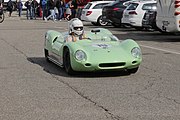Lotus 19
This article relies largely or entirely on a single source. (May 2019) |
| Lotus 19 | |
|---|---|
 | |
| Overview | |
| Manufacturer | Lotus Cars |
| Production | 1960–1962 |
| Designer | Colin Chapman |
| Body and chassis | |
| Class | Group 4 sports car |
| Body style | Fiberglass non-stressed |
| Powertrain | |
| Engine | Coventry Climax FPF |
| Dimensions | |
| Wheelbase | 95 in (2,413 mm) |
| Length | 141 in (3,581 mm) |
| Width | 60.5 in (1,537 mm) |
| Height | 31 in (787 mm) |
| Curb weight | 1,000 lb (454 kg)-1,240 lb (562 kg) (dry) |
| Chronology | |
| Predecessor | Lotus 15 |
| Successor | Lotus 30 |
The Lotus 19 or Monte Carlo is a mid-engine sports-racing car designed by Colin Chapman of Lotus and built from 1960 until 1962.
Lotus 19
The 19 is a mid-engine, rear wheel drive sports racer with a fiberglass body over a space frame, originally designed with 1.5 - 2.75L Coventry Climax FPF engine built for Grand Prix cars, mated to Lotus' own five-speed sequential transaxle nicknamed 'Queerbox' which gave a lot of problems on the Lotus 15, but was improved in its reliability for the Lotus 18. American-engined examples mostly had a Colotti transaxle.
Chapman named the car Monte Carlo to honor Stirling Moss for his win at the 1960 Monaco Grand Prix. Lotus' first F1 victory. This is said to have mimicked and declared competition against the Cooper Monaco, which was named after a win at Monaco in 1958.
19B
Towards the end of 1963, John Klug, founder of Pacesetter Homes Racing, commissioned Lotus to build a special 19 to be Ford V8 powered. Ford's new lightweight iron block 289 c.i. engine was chosen over Oldsmobile's smaller aluminum V8. Roy Campbell finished the car in southern California. Dan Gurney, who had enjoyed considerable success at the wheel of the Arciero Brothers Lotus 19-Climax as the driver.
Because of its unique specification, it was known as the 19B, the only 19 with this designation. Originally delivered in red livery, the car first appeared at Nassau in December 1963. In 1964 it was the fastest sports car in the world, but the car's weak spot was its Colotti transaxle, the failure of which led to a number of retirements. By mid-1965 it was obsolete. It continued racing in southern California and eventually dropped out of sight. Wayne Linden of Roseville, California, found it in a semi trailer waiting to be turned into a dune buggy. He restored it to its early-1964 configuration, except for the Colotti, and ran it in mostly Cobra club events. He sold it to Gordon and Nancy Gimble. Today the car regularly appears at vintage car events in the US and may be on display at Cobra Experience museum in Martinez, Calif.
Chassis numbers
There were seventeen Lotus 19s built, however many were wrecked and some were completely rebuilt.
| Chassis | Original owner | Motor |
|---|---|---|
| 950 | British Racing Partnership | 2.5 Climax |
| 951 | Arciero Brothers | 2.5 Climax |
| 952 | British Racing Partnership sold to Team Rosebud | 2.0 Climax/Ferrari V-12 3.0 in 1963 |
| 953 | British Racing Partnership | 2.5 Climax |
| 954 | J. Frank Harrison | 2.5 Climax later as Harrison Special-289 Ford |
| 955 | Jack Nethercutt | 2.5 Climax |
| 956 | Charles Vogele | 2.5 Climax changed to 2.0 Climax for hillclimbs |
| 957 | Tom Carstens | Empty - 3.5 Buick fitted changed to Chevy V8 |
| 958 | Roy Schechter | 2.5 Climax |
| 959 | Peter Ryan | 2.5 Climax |
| 960 | Robert Publicker | 1.5 Climax |
| 961 | Harry Zweifel | 2.0 Climax for hillclimbs |
| 962 | Rod Carveth | Empty - 3.5 Buick fitted |
| 963 | Henry Olds/Bob Colombosian | Empty - 3.5 Buick fitted |
| 964 | John Coundley | 2.5 Climax |
| 965 | Mecom Racing Team | empty - 2.0 Climax fitted changed to 3.5 Buick |
| 966 | John Klug | 289 Ford |

